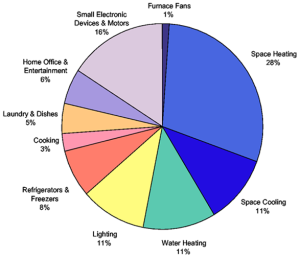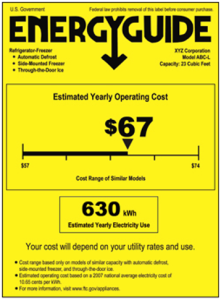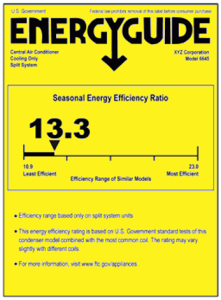Introduction to Energy Efficiency for Consumers
Save Money, Save the Earth: The Importance of Energy-Efficient Appliances
Every time you buy a home appliance, tune up your heating system, or replace a burned-out light bulb, you’re making a decision that affects the environment. You are probably already aware that most of our biggest environmental problems are directly associated with energy production and use: urban smog, oil spills, acid rain, and global warming, to mention a few. But you may not realize just how big a difference each of us can make by taking energy use into account in our household purchasing and maintenance decisions. For an average household with two cars, energy used in the house accounts for more than half of its total energy expenditures.
In fact, choosing energy-efficient appliances is one way you can immediately reduce your contribution to global climate change. Carbon dioxide (CO2) is the primary gas contributing to global warming and virtually all energy-using equipment results in CO2 emissions either directly or indirectly. Most of your electricity is likely to come from burning coal or gas at the power plant. By replacing a 20-year-old refrigerator with a new, energy-efficient model, you will reduce your home’s CO2 contribution by about one ton every year while saving about $80 in reduced electric bills.
What Are My Priorities?
 The decision to make certain energy improvements can be obvious — if you have a broken appliance and need to replace it, for example, use the information on this Web site to make a smart purchase decision. But there may be other important priorities for your house that you are unaware of. If this is the case, you may want to perform a quick self-audit, or go ahead and hire a professional to help find the most cost-effective improvements.
The decision to make certain energy improvements can be obvious — if you have a broken appliance and need to replace it, for example, use the information on this Web site to make a smart purchase decision. But there may be other important priorities for your house that you are unaware of. If this is the case, you may want to perform a quick self-audit, or go ahead and hire a professional to help find the most cost-effective improvements.
As you’re preparing to invest in energy-efficient equipment, focus on the upgrades that will have the highest impact. This pie chart shows how the total energy use of the average U.S. home is split among end uses. You may be surprised to see that certain appliances — like small electronic devices — consume a substantial portion of your house’s total energy use!
Some of the more involved energy improvements make the most sense when you are planning other remodeling work. If you are going to extend a wall out to enlarge your kitchen or put in a larger dormer for a master bedroom expansion, by all means boost energy efficiency at the same time! Rebuild walls with high insulation levels. Put in high-performance insulating windows. With a small addition, some of this work might even pay for itself right away if it means, for example, that you can get by without adding a separate heating system or expanding your current heat distribution system.
To get a rough idea about what energy savings are possible based on the current conditions of your house, go to the Home Energy Saver, produced by Lawrence Berkeley National Laboratory, or energysavvy.com. Enter your zip code along with some details about your home when prompted.
To increase the economic benefits of buying more energy-efficient appliances and boosting your overall home efficiency, check for rebates offered by your local energy and water utilities or tax incentives available from your state or the federal government. Rebates are most common for high-efficiency refrigerators, clothes washers, lighting products, cooling equipment, and home energy improvements like air sealing and insulation. Rebate programs are much more common among electric companies than gas companies, although some gas utilities offer rebates for high-efficiency furnaces and boilers.
If you plan to buy a major appliance soon, call your utility or state energy office to see if rebates are offered for efficient models. Don’t forget to check with your water utility if you are purchasing a dishwasher or washing machine.
What are ENERGY STAR and EnergyGuide?
You can ensure you are purchasing a relatively efficient product by looking for the ENERGY STAR label on refrigerators, freezers, dishwashers, clothes washers, water heaters, central and room air conditioners, heat pumps, furnaces, boilers, lighting products, and numerous electronic appliances. The ENERGY STAR Web site lists products that comply with the label by brand name, product number, major characteristics, and relative efficiencies under each product page. You can view the tables online or download them in Excel format. To find these tables, go to the ENERGY STAR home page and select the appliance category you are searching for at the top left-hand corner. Once on the appliance page, look for “Product Lists” near the top right-hand corner of the page.
ENERGY STAR is designed to highlight the top 25% of covered products based on energy efficiency. For many products, there is a significant difference between the top 5% or 10% and the top 25%— the very best performers can save additional energy and money (and water in the case of clothes washers and dishwashers) compared to other ENERGY STAR-qualified models. For other products, there is no ENERGY STAR program.
New resources are available to help you find the most efficient products available. TopTen USA is an independent nonprofit organization working to identify and publish information about the most energy-efficient products on the market. It maintains lists of top-performing models on its website (www.toptenusa.org) along with tools to help consumers find the products and compare prices from retailers in their local area. TopTen USA is beginning to work with utilities to connect consumers to rebates for listed products. As of 2012, TopTen USA covers refrigerators, freezers, clothes washers, dishwashers, water heaters, televisions, computers, monitors, LED lighting, and vehicles.
About EnergyGuide
When shopping for a new appliance, look for the EnergyGuide label, which should be posted on the appliances on display at retail stores. The EnergyGuide will help you compare the energy use and efficiency of a particular model relative to other available models. The federal government requires manufacturers to affix the label to the following products. ENERGY STAR-qualified models can include the ENERGY STAR mark on the label.
| Group 1 More efficient products on the left end of the scale (lower operating cost) | Group 2 More efficient products on the right end of the scale (greater efficiency) |
|---|---|
| Refrigerators Freezers Dishwashers Clothes washers Water heaters Room air conditioners | Furnaces Boilers Central air conditioners Heat pumps Pool heaters |
On the new label for items in Group 1, the scale in the center of the label shows how the model measures up in terms of estimated annual operating cost. The most efficient products fall on the left end of the scale. Remember, this cost figure is based on average electricity prices and usage patterns, so your costs may vary considerably. Below the scale, a smaller box displays the estimated yearly electricity use (the lower the better). On room air conditioner labels, this box shows the unit’s Energy Efficiency Ratio instead (the higher, the better). On dishwasher and clothes washer labels, a second box provides an alternative operating cost estimate for households with a natural gas water heater.
On the new label for Group 2 equipment, the scale in the center of the label is based on increasing rated efficiency (measured in SEER, HSPF, AFUE, etc). This is because energy use and operating cost varies widely from house to house depending on climate, house size, and other factors. Nonetheless, the efficiency ratings provided by the manufacturer and on the EnergyGuide label are good indicators of relative energy use—the higher the efficiency rating, the lower the operating cost.

